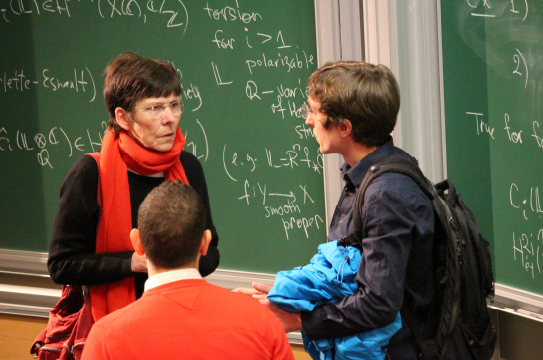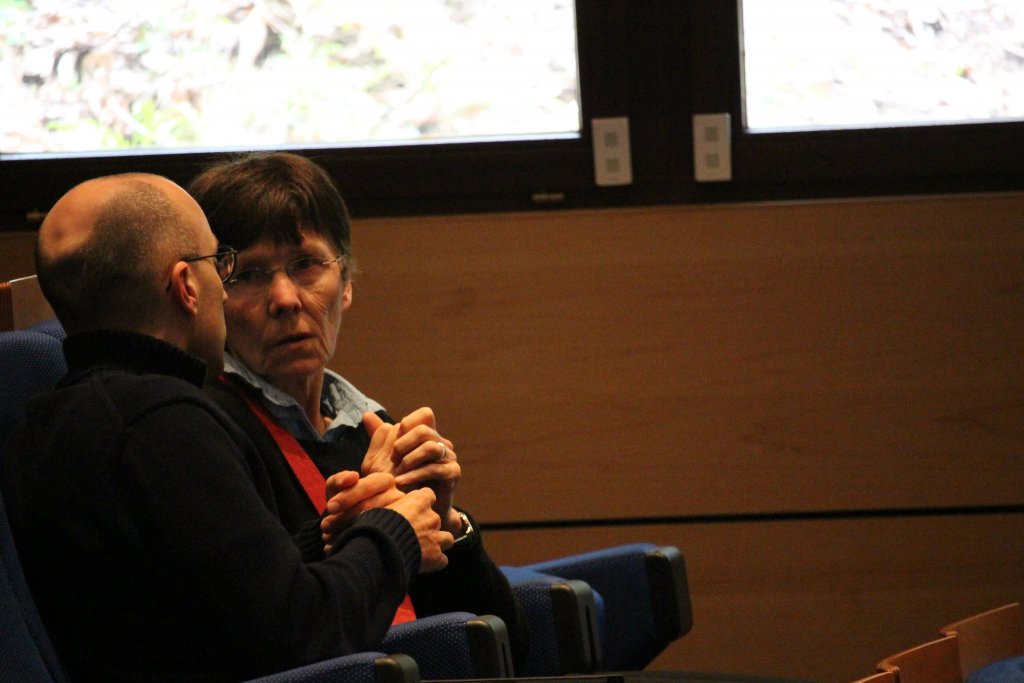 IHES
IHES
Interview with Hélène Esnault
The picture above shows Marco D’Addezio, Hélène Esnault and Alexander Petrov.
In the week of April 22, 2024, IHES hosted a conference in honor of Hélène Esnault, a world-renowned specialist in the field of arithmetic geometry. Read our short Q&A with Hélène below.
Hélène, your first scientific visit to IHES dates back to 1988. You were also a member of the IHES scientific council from 2015 to 2023. Could you tell us more about your relationship with the Institute?
I first came to IHES in the early 1980s to discuss the second part of my habilitation (“thèse d’État” at this time in France) with Pierre Deligne.
The thèse d’État consisted of two parts. The first part involved presenting one’s own research. For the second part (“deuxième thèse” in French), you were assigned a topic other than the one you were directly working on and were expected to report on the state of research in that field. The idea was to ensure that future researchers were capable of broadly understanding topics with which they were not directly familiar.
Jean-Louis Verdier had offered to be the advisor for the first part of my thèse d’État. He suggested that I go see Pierre Deligne at IHES for the second part. It was very intimidating. To my surprise, Deligne immediately agreed to be my supervisor, and I ended up working on the preservation of perversity by the vanishing cycles functor. This is a very technical subject, and I didn’t fully grasp all its subtleties back then, and perhaps still now don’t. In particular, my understanding of one point was quite vague, and Deligne feared that Ofer Gabber might challenge me on it during the defense. He explained to me how to respond to a potential question by Ofer on this point. Ofer’s question indeed came quickly, but the response Deligne had suggested helped me manage the situation. I can still see the smile on Deligne’s face at that question. His welcoming attitude, kindness, and intellectual trust have given me moments of mathematical joy throughout my career. He also helped me overcome difficult times, such as when Eckart Viehweg, my partner and later my husband, passed away in 2010. Pierre invited me to his house in Princeton, offering me his time and wonderful discussions.
Over the years, I have come to IHES several times for scientific visits, sometimes with Eckart. At the beginning, Marcel Berger was still the Director of the Institute. We were very different in many ways—we didn’t work on the same kind of mathematics, and our political and cultural views were far apart—but we got along. He even kindly invited me to dinner at his house one evening. Later, Jean-Pierre Bourguignon succeeded him as the Director of the Institute. Jean-Pierre is interested in Germany and also speaks German, which created a sense of complicity. I have always maintained good relations with the Institute. It was a pleasure for me to accept the invitation from Emmanuel Ullmo, the current Director, and from the Permanent Professors of IHES, to join the Institute’s Scientific Council in 2015.
Here, I once again met wonderful people. Let me tell you a story that illustrates this well. The physicist Slava Rychkov had offered to drive me to Bures on a Saturday morning for a Scientific Council meeting, as his apartment was not far from where I was staying. In the car, we talked about poetry and, getting carried away, we started reciting verses out loud in Russian, German, and French. It was wonderful, but we ended up missing the highway exit… We were sheepishly arriving (a little) late.
In general, I feel truly at ease at IHES. The kindness and attention of the entire staff are a ray of sunshine to me. Being able to interact with Dustin Clausen, Maxim Kontsevich and Emmanuel Ullmo who are working in fields of research close to mine, is truly a privilege and a pleasure.
We just celebrated your birthday with a conference that was very successful. We have never received so many participation requests for a scientific conference. What do you take away from this week at IHES?
First of all, that mathematics is a wonderful human adventure! As a matter of fact, mathematics has long been a collective, international endeavor. This aspect is particularly close to my heart, and I am happy to see that this diversity was visible during the conference. The role of the social and cultural background is much less significant in mathematics than in other disciplines. For me, mathematics has played a key role in my emancipation. I am always fascinated to see how mathematical activity brings together people from very different origins. It is also striking to see that mathematics transcends age. Generational barriers do not exist in mathematics! The work of young mathematicians never ceases to amaze me, and I had the immense luck to mentor my students and some young researchers at the beginning of their career. I have learned so much from them! It is also mainly thanks to my students that this conference took place, and I wish to warmly thank them for organizing this extraordinary week. I also do not forget my long-time colleagues, some of whom I have worked with for over 40 years! As mentioned earlier, our relationships go far beyond mathematics. The piano concert by Yves André on the first day of the conference is a touching testimony of these friendships that deeply moved me.
Finally, the quality of the lectures was remarkable. I think the conference showed that arithmetic geometry is a particularly dynamic field, at the forefront of mathematics. Many new methods have recently been introduced in arithmetic geometry, and their potential is yet to be fully explored.

Your work with Michael Groechenig enabled Jonathan Pila, Ananth N. Shankar, and Jacob Tsimerman solve the André-Oort conjecture in 2021. What are examples of open problems in arithmetic geometry that you continue to think about today?
I would like to further understand the connections between the geometry of certain smooth projective varieties and the existence of rational points on these varieties when the base field is a C1 field (generalizing the notion of an algebraically closed field). This research program was initiated by Yuri Manin in the 1960s and marks the beginning of the exploration of interconnections between certain geometric and arithmetic properties. For example, the Lang-Manin conjecture predicts that a rationally connected smooth projective variety has a rational point over a C1 field. We have partial results for certain kinds of fields known to be C1. For instance, I proved the conjecture for finite fields in 2002. We also know that the conjecture is true over some other fields. However, we do not have an exhaustive list of C1 fields. There are very “trendy” fields conjectured to be C1, such as the field of functions of the twisted projective line or that of the Fargues-Fontaine curve.
In another area, more closely related to the methods mentioned in your question, Vikram Mehta and I proved a conjecture by David Gieseker in 2010 stipulating that a smooth geometrically simply connected projective variety over a perfect field in characteristic p does not admit non-constant stratified bundles. A conjecture by Johan de Jong predicts a similar result for isocrystals. With Atsushi Shiho, we obtained a small result in this direction, but we are still far from understanding the conjecture in its full generality. One might think there is a link between this conjecture, the Langlands program, and, hopefully, thoughts we currently develop with Michael Groechenig.
These are some questions I wish I knew more about. There are other thoughts related to my work with Moritz Kerz that I could talk about, but they are more difficult to sketch out for this interview.




